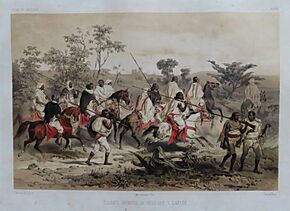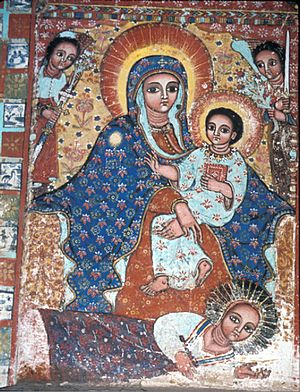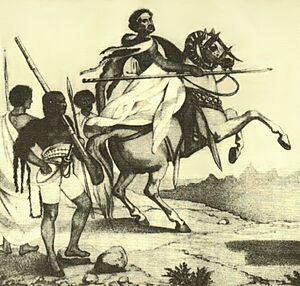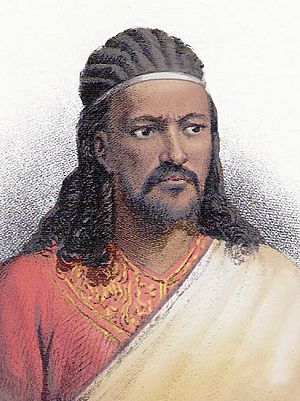Zemene Mesafint facts for kids
Quick facts for kids Zemene Mesafint period |
|
|---|---|
| 1769–1855 | |

Ethiopian warriors during the Zemene Mesafint
|
The Zemene Mesafint (Ge'ez: ዘመነ መሳፍንት) means "Era of Princes" or "Era of Judges." It was a time in Ethiopian history when the country was not ruled by a strong emperor. Instead, powerful noble families, mostly from the Oromo group, held the real power. The emperor, who was from the Solomonic dynasty, became just a figurehead. This means he was still the official ruler, but he had very little actual power. He mostly stayed in the capital city of Gondar.
During this period, many powerful families were connected by marriage. They formed a stable group of rulers. This lasted until the mid-19th century. The most powerful family was the House of Yejju. They were based in a region called Yejju in Wollo. Famous leaders from this family included Ali I of Yejju, Aligaz, Gugsa, and Ali II.
Other important regional leaders included Kenfu Hailu of Gondar and Sabagadis Woldu of Tigre. These lords often fought each other. They wanted to expand their lands and become the main protectors of the emperor in Gondar. Even though the emperor had little power, his position was still seen as very important and sacred. This helped the royal family survive.
The Zemene Mesafint ended when a local leader named Kassa Hailu rose to power. He was an "outlaw," meaning he was outside the usual system. Kassa Hailu gained support from people and defeated the powerful Oromo lords. He then crowned himself Tewodros II. He wanted to bring back the glory of the Ethiopian Empire.
Contents
A Time of Change in Ethiopia
How the Era Began
Historians often mark the start of the Zemene Mesafint in 1769. This was when a powerful leader named Mikael Sehul removed Emperor Iyoas I from power. The era ended in 1855 when Kassa Hailu became Emperor Tewodros II. He had defeated all his rivals in battle. Some historians think the period started even earlier, around 1706. This was when Emperor Iyasu I died, and the royal family's power began to weaken.
During this time, powerful lords sometimes put their own chosen emperors on the throne. For example, after Emperor Tewoflos died in 1711, nobles chose Yostos to be king. They wanted to stop the fighting between royal family members. But Yostos's rule was short, and the throne soon returned to the Solomonic dynasty.
Emperors and Regents
Emperor Iyasu II and Empress Mentewab
The rule of Iyasu II (1730–1755) also brought problems to the empire. He became emperor when he was a child. This allowed his mother, Empress Mentewab, to rule for him. She was a "Regent," meaning she governed until the emperor was old enough. Mentewab even crowned herself as a co-ruler in 1730. She was the first woman in Ethiopia to do this.
Beyond the capital city of Gondar, the empire faced many local conflicts. Different regions, like the Agaw, Amharics, Tigrayans, and Oromo, fought among themselves.
Emperor Iyoas I and the Queens
Empress Mentewab tried to make the royal family stronger by connecting with the Oromo people. She arranged for her son, Iyasu, to marry Wubit, an Oromo chieftain's daughter. But this plan caused problems later. After Iyasu died in 1755, Mentewab wanted to keep her power. But Iyasu's widow, Wubit, thought it was her turn to be regent for her son, Iyoas.
When Iyoas became emperor, people in Gondar were surprised. He preferred to speak the Oromo language instead of Amharic. He also favored his mother Wubit's Oromo relatives over his grandmother Mentewab's family. Iyoas gave even more power to the Oromo.
The conflict between these two powerful queens grew. Mentewab called her family and their armed supporters to Gondar. Wubit responded by calling her Oromo relatives and their large forces. People feared a war between the two groups. So, they asked the powerful leader Mikael Sehul to help. He came and cleverly took power for himself, pushing aside both queens.
Emperor Iyoas's rule became a struggle between Mikael Sehul and Iyoas's Oromo relatives. Iyoas had little power because the royal treasury was empty. He relied heavily on his Oromo family. As he favored Oromo leaders, his relationship with Mikael Sehul worsened. Finally, Mikael Sehul removed Emperor Iyoas from power in 1769. A week later, Mikael Sehul had him killed. This was a big moment because it was the first time an emperor was removed from his throne by force. This event is often seen as the true beginning of the Era of Princes.
More Conflicts and New Rulers
After Iyoas, an old royal uncle, Yohannes II, became emperor. But Ras Mikael soon had him killed. Then, a young boy, Tekle Haymanot II, was made emperor. Mikael Sehul was later defeated in battles. Other powerful leaders then put their own emperors on the throne. These leaders constantly changed emperors. Tekle Giyorgis was even made emperor six times and removed six times!
Meanwhile, Amha Iyasus, a ruler in Shewa, stayed out of these fights. He focused on making his own kingdom stronger. His successors continued this wise practice.
The years from 1771 to 1784 were a time of change. The old system of absolute monarchy was ending. A new era of rule by the Were Sheikh leaders of Yejju was beginning. Tekle Giyorgis I tried to bring back the emperor's power. But he failed. Ali I defeated him in 1784. Ali I then put Iyasu III, who was his puppet, on the throne. Two years later, in 1786, Ali I became a very powerful leader. This marked the start of the Yejju dynasty, also known as the Wara Seh dynasty. Ras Ali I and his family became "Enderase," which means Regents of the Ethiopian Empire. They ruled in the emperor's name.
Power then passed from Ras Ali I to his brother Ras Aligaz. After Aligaz died, Ras Wolde Selassie briefly took power. But then it returned to Aligaz's nephew, Ras Gugsa. Gugsa then passed power to his sons. Finally, Ras Ali II, another nephew of Ras Gugsa, became the Enderase.
The Warra Seh (Yejju) Rulers
Historians agree that the Yejju lords, also called the Warra Sheh (meaning "sons of the Sheikh"), were a stable ruling group. They had different backgrounds but ruled the country in the name of the Solomonic emperors. They preferred to be called Warra Sheh. This name showed their Muslim and Oromo roots.
Scholars believe that Ras Gugsa's rule (1800–1825) was mostly peaceful. The Warra Sheh rulers had a lot of power over other lords. These other lords had to pay them taxes and attend their court. They also had to fight in the Warra Sheh's wars. The Warra Sheh could even confirm new lords in their positions. Sometimes, they would chain up lords who did not obey them.
The End of the Zemene Mesafint
The Zemene Mesafint period lasted for 86 years. During this time, 23 emperors sat on the throne. Some were put on and removed from power many times. This era finally ended with the rise of Kassa Hailu. He is better known by his later name, Tewodros II.
Kassa Hailu first took control of Dembea. Then, he won a series of battles, starting with Gur Amba in 1852. He ended with the Battle of Derasge in 1855. He gained control of all of northern Ethiopia. Most importantly, he defeated Ras Ali II at the Battle of Ayshal. This ended the Were Seh dynasty. With one man holding imperial power again, the Zemene Mesafint was over. This marked the beginning of modern Ethiopian history.




